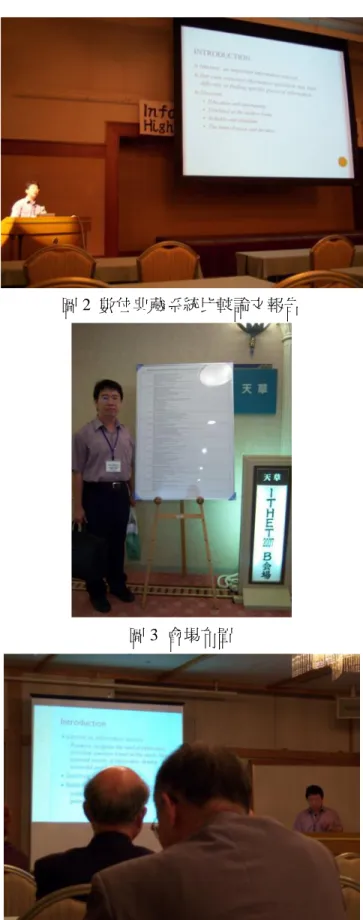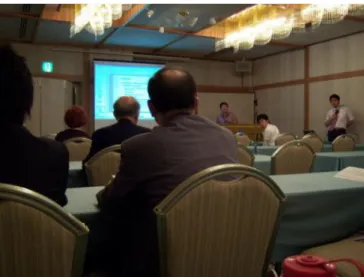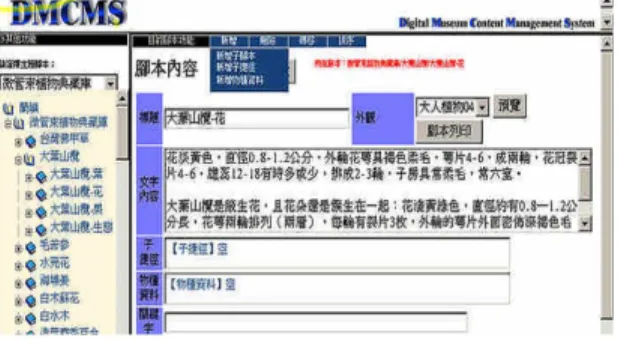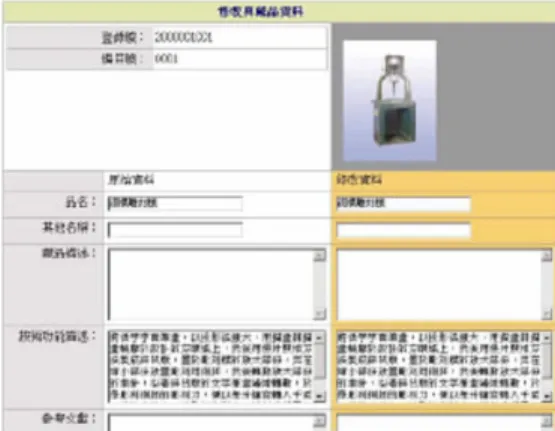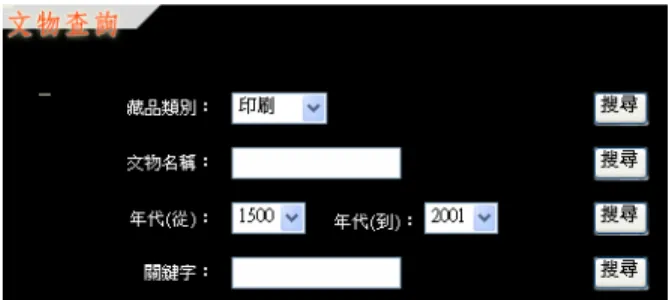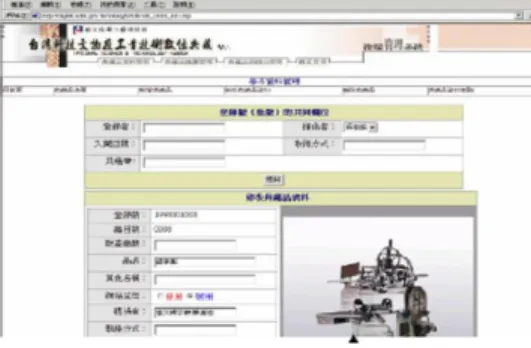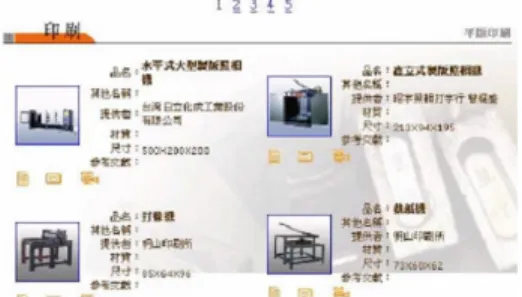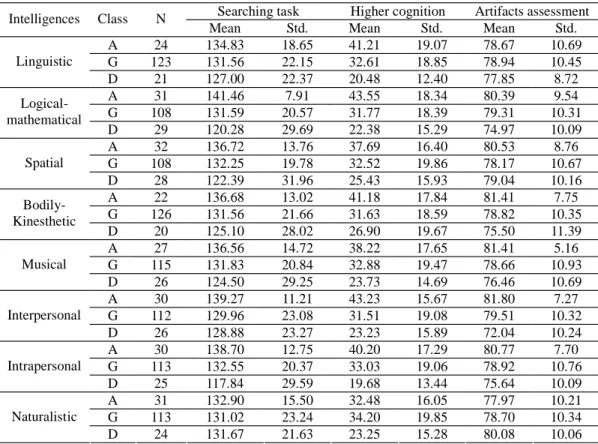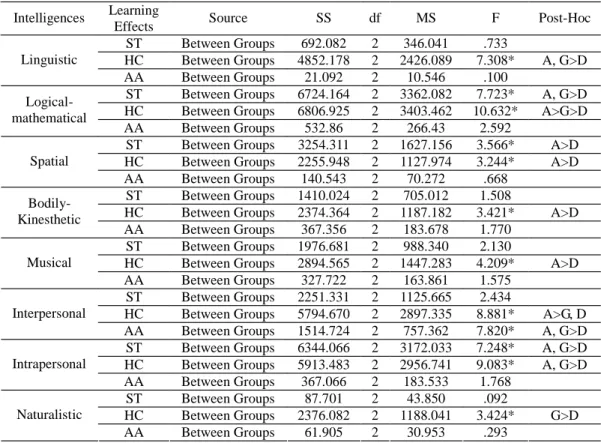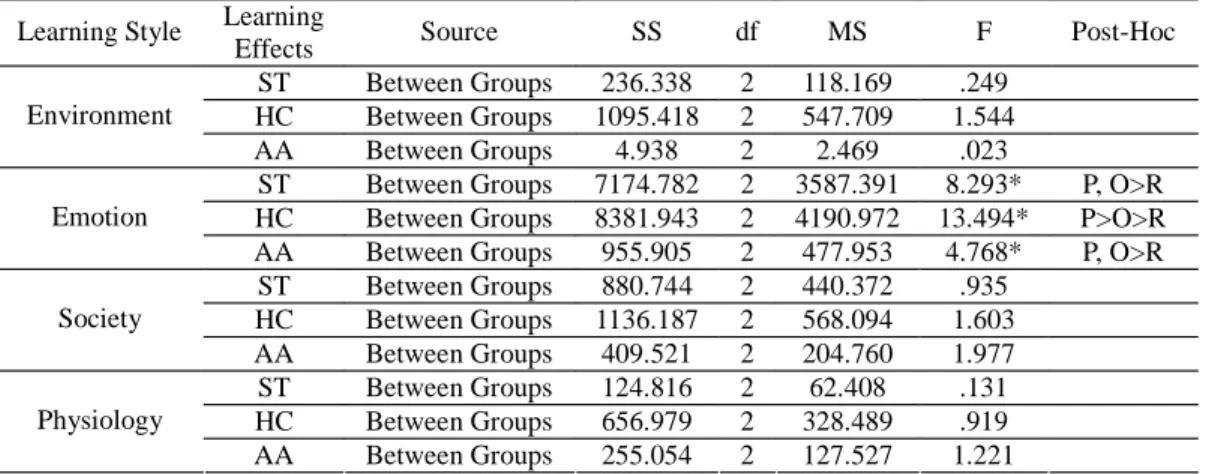摘要
大六教學法是一種有效運用科技的資訊問題解決策略,本研究選取高雄市一所國民
小學 99 位五年級學生參與實驗教學,以大六教學法設計合適的自然與生活科技領域學
習活動,製作科技產品,探討對高、中、低分群學生之創造力與科技創造力的影響。研
究結果如下:
(1)三個群組在流暢力、獨創力與精密力前測具有顯著差異,但是在後測
則無顯著差異;
(2)共變數分析前後測影響,三個分群並無顯著差異,但對全體學生而
言,在變通力、獨創力與精密力獲得顯著的提升;
(3)三個群組的科技創造力在流暢力
與變通力具有顯著差異。
關鍵詞:大六教學法、創造力、問題解決能力、科技創造力。
Abstract
The Big Six Skills is a systematic approach to information problem-solving with
technology. In this study, ninety-nine fifth grade students divided into high score, middle
score, and low score according to their academic achievement in science and technology then
implemented the Big Six Skills to learn the project of convex and concave lens. The revised
Williams Creative Assessment was used as the pre-post tests to assess the creative ability of
fluency, flexibility, originality, and elaboration of students. The students should write a plan to
design and manufacture an artifact with convex or concave lens as their representation of the
technological creativity. The results were as follows: (a) there was significant difference on
the fluency, originality, and elaboration among the three groups in pretest; but there is no
significant difference among them in posttest; (b) by ANCOVA test, there was no significant
difference in the effect of the creativity among the three groups; but there was significant
difference on the flexibility, originality, and elaboration of whole students; (c) there was
significant difference on the fluency and flexibility of technological creativity among the
three groups.
Keywords: Big six skills, Creativity, Problem solving ability, Technological Creativity.
1. 緒論
1.1 研究背景與動機
二十一世紀是「學習革命」的世紀,傳統的學習方法勢必無法接受「資訊社會」龐
雜的資訊量和資訊科技等多重障幕的考驗。資訊時代的學習觀,是以能力培養、學科整
合、社群合作、資源整合、建構理論、批判思考及終身學習為目標導向的學習觀。在學
習上,學生對於資訊的收集、管理和使用的方式,將會影響到學習成效。學習不再只是
對知識的記憶,而是如何蒐集資料,整理資料並進一步運用習得的事物來解決生活上所
遇到的問題。
1998)。
Eisenberg and Berkowitz(1988)所提出的大六教學法(Big Six Skills, Big 6)是目
前在美國學校教育中,普遍被運用於多種的課程活動,藉以幫助學生在處理資訊過程中
運用系統性策略與批判性思考,以解決問題。同時也是一種解決資訊問題的技巧,它可
以幫助及解決學校作業和生活上的問題,當學生遇到資訊問題要解決時,使用大六技能
來搜尋、運用、整合和評鑑資訊時,將能更有效的解決問題。藉由大六教學法的概念設
計課程,讓學生學習大六教學法的技巧,其步驟為定義問題、資訊查詢策略、找尋與查
詢資訊、利用資訊、整合及評鑑,培養學生運用科技與資訊及主動探索與研究的能力。
長期以來,傳統教育與升學主義的影響至今依然,教學過度重視標準答案,阻礙了
創造思考能力的發展,使學生所學偏重記憶並著重於應付考試,而忽略創造思考與問題
解決能力的培育,以致於難以培養出積極主動及團隊精神的人才。而在「九年一貫課程」
的「自然與生活科技」領域重視手腦並用、設計與製作、知能與態度並重,其課程目標
在協助學生察覺、試探人與科技的互動關係;習得基本的科技知能與學習方法,應用於
當前和未來的生活及培養個人及團隊問題解決能力,並激發創新興趣與潛能。
本研究以資訊問題解決策略 Big 6 教學法,結合自然與生活科技領域學習主題「凸
透鏡與凹透鏡」,讓國小五年級學童進行相關科學與技術的認知學習,並認識相關科技
產品發展的過程,進而從事設計與製作簡易的科技產品,以 Williams 創造力測驗評量
學業成就高中、低分群學童之創造力表現,並從學童的作品中評量其科技創造力的表
現,提出運用資訊科技輔助學童發展科技創造力適當的教學策略與建議。
1.2 研究目的
(一)國小五年級學業成就高、中、低分群學童運用資訊問題解決策略 Big 6 教學法,
學習自然與生活科技領域主題「凸透鏡與凹透鏡」,其 Williams 創造力測驗之
前後測結果分析。
(二)國小五年級學業成就高、中、低分群學童運用資訊問題解決策略 Big 6 教學法,
學習自然與生活科技領域主題「凸透鏡與凹透鏡」,其 Williams 創造力測驗之
前後測成效分析。
(三)國小五年級受試者全體學童運用資訊問題解決策略 Big 6 教學法,學習自然與生
活科技領域主題「凸透鏡與凹透鏡」,其 Williams 創造力測驗之前後測成效分
析。
(四)國小五年級學業成就高、中、低分群學童運用資訊問題解決策略 Big 6 教學法,
學習自然與生活科技領域主題「凸透鏡與凹透鏡」,其科技創造力評量結果分析。
2. 文獻探討
2.1 大六教學法
(二)資訊查詢策略(Information Seeking Strategies):運用腦力激盪法,決定可能的資
訊來源範圍,決定不同資訊的順序,選擇最佳的資訊來源。
(三)找尋與查詢資訊(Location of and Access to Information):定位資訊來源的所在位
置,從來源中找到所需的資訊。
(四)利用資訊(Use of Information):在資訊來源中,進行資訊的判讀,並摘錄有關的
資訊。
(五)整合(Synthesis):由眾多的資料來源中,重新組織資訊,並展示整合的資訊。
(六)評鑑(Evaluation):判斷作品的有效性及資訊問題解決歷程的效能。
Johnson(1999)參考大六的模式設計了一套幼稚園到八年級的資訊課程,每個課程
涵蓋四個單元:1.研究與詢問技能:此為基本的圖書館技能;2.終身閱讀:包括各種文
學的閱讀;3.科技技能:包括電腦的應用文書處理與網路等科技及;4.適當的利用資源:
包括媒體中心各種資源的利用規範。
Wolf(2000)以 Big 6 資訊處理過程做為後設認知鷹架,指導學生完成美國黑人爭
取公民權利事件的報導式專題研究。學生從事件光碟資料庫中,依 Big 6 資訊問題解決
技巧,完成教師指派的任務。研究者蒐集前後測資料、專題成果報告、教室研究過程觀
察記錄、學生問卷調查、協同教師及部分學生訪談資料分析。結果發現 Big 6 技巧在解
決資訊問題時,是一種有效的後設認知鷹架,以 Big 6 為後設鷹架學習的實驗組學生,
在報紙報導專題製作上獲得較高的成就,不過在學習的態度上,兩組並沒有顯著差異,
但實驗組表示喜歡以專題的方式來進行學習。
2.2 創造力
Guilford(1977)將智慧分為心智運作(intellectual operation) 、材料(content)、以及產
品(product)三個變項(parameters),每一個變項由一些基本的要素組成。創造力可由這些
心智運作產生,材料是指創造力表現的內容;產品則是創造力的分類別。而擴散式思考
(divergent thinking)則包含了:流暢性(fluency)、變通力(flexibility)、獨創性(originality)
與精密性(elaboration)等要素(Dembo,1994)。
Michael(1977)指出創造力是產生新奇觀念,從過去的經驗中,產生從來沒有過的
獨特產品,以獨特有用的方法,解決問題的能力。Mary(1985)認為創造力是一種思考
和行動的方法,亦是一個人獨特思考後的價值呈現,它可能是一種解決問題的歷程,也
可能是生產一些新產品的過程。Dass(2000)認為創造力是能將各元素整理或重整,以
達到新的或有效率的生產過程。Torrance(1984)認為創造力包括流暢力、變通力、獨
創力和精進力。
Amabile(1983)從「產品」的角度定義創造力,並提出創造力的成份模式(componential
model)以做為社會心理領域研究創造力的理論基礎。根據 Amabile 的看法,所謂創造力
的表現即經過專家評定為有創意的反應或工作的「產出」(product)。她認為創意產品的
誕生至少必須仰賴三個基本成份:領域相關的技能(domain-relevant skills)、創造力相關
的技能(creativity-relevant skills)、和工作動機(task motivation)。在創造歷程中,這三個成
份會不斷地互動,進而影響個體的創意表現。
2.3 科技創造力
Runco, Plucker and Lim(2001)指出,
「創造力經常是根據產品來定義的。」
。Sternberg
and Lubart(1999)認為創造力係產生新奇與適當產品的能力。Amabile(1997)認為創
造 是 一 種 歷 程 , 但 最 終 還 是 產 品 必 須 符 合 新 奇 性 、 適 切 性 、 有 用 性 與 價 值 性 。
Csikszentmihalyi(1999)則強調創造力必須對環境產生某種程度的影響,創造力必須改
變既有領域,或是將既有領域改變成為新的領域的任何想法、行為或產品。
「科技創造力」係植基於一般的創造力,其創作歷程與重要的影響因素二者重疊部
分佔大部分,但科技創造力應還是有些因子是獨立於一般創造力之外及強調的重點不
同。許多學者認為相關的領域背景知識是科技創造發明成敗的重要關鍵;所有的創作,
必須基於領域知識的建立,尤其是科技創造力更須要豐富的背景領域知識(Dasgupta,
1996; Janssen,1997; Ram & Leake, 1995)。
「科技」與「科學」本分屬不同專業領域,嚴格說來,科學提供理論基礎,讓人類
可以發明更多的科技產品;新科技的發明,讓人類藉以拓展其探索的能力,並能發展或
發現更多更正確的科學理論。Dasgupta(1996)更明確指出設計(design)與發明(invention)
為科技創造力的具體展現。因此,科技創造力係科學、技術知識、科學問題的解决和創
造活動過程中,根據一定的目的和任務,運用一切已知信息,產生或可能產生某種新穎、
獨特、有社會或個人價值的產品或能力(李賢哲,2001)。
3. 研究方法
3.1 研究對象
本研究選自高雄市某國小五年級 99 位學生參與實驗教學,運用資訊問題解決大六
教學法學習自然與生活科技領域主題「凸透鏡與凹透鏡」,並根據其該領域的學習成就
成績前 27%為高分群,共 27 位,後 27%低分群,共 27 位,其餘為中分群,共 45 位,比
較其創造力表現差異。
3.2 大六教學法實施步驟
(一)
定義問題:學生利用網路搜尋有關凸透鏡與凹透鏡的相關知識,與其課堂所學進
行知識整合活動。
(二)資訊查詢策略:學生找出可以提供其製作相關產品的資訊來源,並評估決定哪些
資訊來源是可以使用的。
H: 高分群; M: 中分群; L: 低分群; *p<.05
5. 結論與建議
綜上所述,本研究獲得以下結論:
(一)大六教學法對高、中、低分群學生在流暢力、變通力、獨創力與精密力的表現,
均有所提升。
(二)經由威廉斯創造力前後測變異數分析,高、中、低分群之間的前測在流暢力、獨
創力與精密力具有顯著差異;但是後測顯示三個分群之間已無顯著差異。
(三)共變數分析結果顯示,三個分群所獲得的創造力提升並無顯著差異;但是,對整
體學習成效而言,在變通力、獨創力與精密力獲得顯著的提升。
(四)實驗教學後,科技創造力方面,大六教學法對高分群學生在流暢力與變通力有顯
著的影響,在獨創力與精密力方面,三個分群之間並無顯著差異。
因此,本研究提出下列建議:
(一)運用資訊科技學習各領域知識已是既定趨勢與潮流,大六教學法所提供的系統性
學習策略有助於學生在龐大的網路資訊庫中,建構統整出系統性的知識體。
(二)經由網路資訊提供,猶如所謂「站在巨人的肩膀上」,提供學生更寬廣視野,亦
能培養其創造力使其獲得提升。
(三)科技創造涉及有關技術方面的培養,須要配合其他有效的技能培養策略。
參考文獻
[1]李賢哲。2001。以動手做(DIY)工藝的興趣培養中小學童具科學創造力之人格特質。
科學教育月刊。243。pp.1-7。
[2]林幸台、王木榮。1994。威廉斯創造力測驗指導手冊。台北:心理出版社。
[3]張基成。1997。開發創造思考與創造力之知識建構工具與認知學習環境的探討:電腦
的革新應用。教學科技與媒體。33。pp.36-45。
[4]張國恩。1999。資訊融入各科教學之內涵與實施。資訊與教育雜誌。72。pp.2-9。
[5]A. Ram and D. B. Leake, Goal-driven learning. London: A Bradeford Bood, 1995.
[6]D. Johnson, “
Implementing an information curriculum﹕On
e
di
s
t
r
i
c
t
’
s
s
t
or
y.”Retrieved
June
20,
2007
from
the
World
Wide
Web:
http://www.doug-johnson.com/articles/one-district-story.html
, 1999.
[7]D. H. Janssen, “
Instructional design models for well-structured and ill-structured problem
solving learning outcomes.”Educational Technology Research & Development, 45(1),
pp.45-94, 1997.
[8]E. P. Torrance, The nature of creativity as manifest in its testing. NY: Cambridge
University Press, 1984.
[9]F. E. Williams, Classroom ideas for encouraging thinking and felling. (2nd ed). NY:
D.O.K. publishers. Inc., 1970.
[10] J. C. Hong, “
The power of technological creativity.”Taipei, Taiwan: The international
conference on creativity development in technical education and training, 1997.
[11] J. P. Guilford, Way beyond the IQ. New York: Creative Education Foundation, Inc.,
1977.
54(10), pp.821-827, 1999.
[13] M. Mary, Creative activities for young children (3rd Ed.). Delmar Publisher, 1985.
[14] M. A. Runco, J. A. Plucker and W. Lim, “
Development andpsychometric integrity of a
measure of ideational behavior.”Creativity Research Journal, 13, pp.393-400, 2001.
[15] M. B. Eisenberg and R. E. Berkowitz, “
Library and information skills curriculum scope
and sequence: The big six skills.”School Library Media Activities Monthly, 5(1),
pp.26-28, 45, 50-51, 1988.
[16] M. B. Eisenberg and R. E. Berkowitz, Teaching information & technology skills: The
Big6 in elementary school. Worthimgton, Ohio: Linworth Publishing, 1999.
[17] M. B. Eisenberg, “
A Big 6? skills overview.”Retrieved May 25, 2007 from the World
Wide Web:
http://www.big6.com
, 2001.
[18] M. H. Dembo, Applying educational psychology (5th ed.). New York: Longman
Publishing Group, 1994.
[19] M. P. Dass, “
Preparing coaches for the changing game of science: Teaching in multiple
domains.”The Clearing House, 74, pp.39-41, 2000.
[20] R. Oliver and A. Omari, “
Exploring student interactions in collaborative World Wide
Web computer-based learning environments.”Journal of Educational Multimedia and
Hypermedia, 7(2), pp.263-287, 1998.
[21] R. J. Sternberg and T. I. Lubart, “
The concept of creativity: Prospects and paradigms.”In
R. J. Sternberg (Ed.), Handbook of creativity, pp. 3-15. New York: Cambridge University
Press, 1999.
[22] S. Dasgupta, Technology and creativity. New York: Oxford Universiry Press, 1996.
[23] S. Wolf, The Big Six information skills as a meta-cognitive scaffold in solving
information based problems. Unpublished doctoral dissertation. Arizona State University,
Tempe, 2000.
[24] S. J. Parnes, Creative behavior guidebook.
NY:
Cha
l
e
s
Sc
r
i
hne
r
’
s
s
ons
, 1967.
[25] T. M. Amabile, The social psychology of creativity, NY: Springer-Verlag, 1983.
[26] T. M. Amabile, “
Entrepreneurial creativity through motivational synergy.”Journal of
Creativity Behavior, 31(1), pp.18-26, 1997.
[27] W. B. Michael, Cognitive and affective components of creativity in mathematics and the
physical science. Johns Hopkins University, 1977.
計劃成果自評
這個計畫的研究成果,目前發表了一篇國內研討會論文與四篇國際研討會論文研究成果
十分豐碩。
發表著作
研討會論文
Peng-Heng Tsai, Jerome Weng ,Tien-Yu Huang (2008). TRAINING CREATIVITY AND
TECHNOLOGICAL CREATIVITY: EFFECTS OF BIG SIX SKILLS IN MAKING A CREATION.
CONFERENCE OF ASIAN SCIENCE EDUCATION. (NSC95-2520-S-153-001)
(NSC95-2520-S-153-001)
Peng-Heng Tsai, Jerome Weng ,Tien-Yu Huang (2007). Big Six Skills in
Promoting Creativity and Technological Creativity. The 2007 International
Joint Conference on e-commerce, e-Administration, e-Society, and
e-Education. 2007.8.15~17, pp.171. Best Paper Award.
(NSC95-2520-S-153-001)
Peng-Heng Tsai, Jerome Weng ,Tien-Yu Huang (2007). The Effect of Multiple
Intelligences and Learning Style Preferences in Training information
Capability. ITHET 2007, 8th International Conference on Information
Technology Based Higher Education and Training. 2007.7.10~13, pp.62. EI
Proceeding. (NSC95-2520-S-153-001)
出國報告(出國類別:研究成果發表)
8th International Conference on
Information Technology Based
Higher Education and Training
(ITHET2007)
&
International Conference on
e-Education
服務機關:國立屏東教育大學資訊科學系
姓名職稱:研究助理
蔡秉恆
派赴國家:
Kumamoto City
,
Japan
Hong Kong
出國期間:9–14 July 2007
August 15-17, 2007
報告日期:10–13 July 2006
摘要
本 研 究 承 國 科 會 研 究 計 畫 編 號
NSC94-2520-S-153-002
及
NSC95-2520-S-153-001 經費贊助,得以完成各項研究,並將成果發表於國外研討
會, 與外國學者共同討論 ,增進學術研究品質與視野 。 首先係 將計畫編號
NSC94-2520-S-153-002 以數位典藏國家型科技計劃 所進行建置之系統架構探討
與實驗教學之應用研究的成果 ,發表於日本九州熊本縣所舉辦之
8th International Conference on Information Technology Based Higher Education and Training (ITHET2007),該研討會為 EI
p
r
o
c
e
e
d
i
n
g,其中針對數位典藏系統架構所探討之研
究結果發表在 Development and use of IT Tools and Environments 主題中,另外應
用數位典藏進行實驗教學並以學生之多元智能與學習風格進行學習成效分析研
究成果發表於 Network based education and training 主題中;並再將計畫編號
NSC95-2520-S-153-001 以大六教學法促進學生之創造力與科技創造力之研究成
高、中、低分群學生在流暢力、獨創力與精密力具有顯著差異,實驗教學後三個
分群學生之創造力表現未達顯著差異,以共變數分析,高、中、低分群之間在實
驗教學前後並無顯著差異,但以全體創造力表現在實驗教學前後,在變通力、獨
創力與精密力獲得顯著的進步成效,由此得知,學生之創造力表現在實驗教學前
所具有之顯著差異,在實驗教學後成為無顯著差異,即實驗教學前後創造力表現
高、中、低分群學生所獲得提升之效果並無顯著差異 ,而全體總合之結果獲得顯
著的提升效果,表示學生接受大六教學法對於促進創造力之提升具有良好的影響
效果。此外,從學生的科技創造作品分析其科技創造力表現 ,以變異數分析,發
現在流暢力與變通力方面,高、中、低分群學生具有顯著差異,可見學生經由網
路所獲得的資訊刺激,各分群學生在獨創力與精密力方面並無差異,各分群學生
對資訊接收之主要差異顯示在流暢力與變通力方面 。
過程
計畫原擬訂參加在 San Antonio, Texas, USA 所舉辦的 The 18
th圖 2 數位典藏系統比較論文報告
圖 3 會場布置
The Differences and Efficiency of Constructing Digital Museums
Jerome Weng
1, Peng-Heng Tsai
2, Tien-Yu Huang
3 1Department and Graduate Schoo l of Information Management , Shu-Te University . 2
Department of Industrial Technology Education, National Kaohsiung Normal University. 3
Department of Computer Science, National Pingtung University of Education. jerome@mail.stu.edu.tw;penghen.tsai@msa.hinet.net ;tyhuang@mail.npue.edu.tw
Abstract
The digital museum could digitize the various collections to preserve, popularize, and revitalize heritage via World Wide Web. This study investigated the differences and efficiency of the two digital museums (Lanyü Digital Museum, LDM; Taiwan Technology Relics and Industry Technique Digital Museum, TTRIT). The results were as follows:(1) the digital content of LDM was flash -based documents, but the TTRITs was hypertext; (2) the LDM managed the database used the digital museum content management system (DMCMS) developed by itself and used the SQL to arrange its database; the TTRIT used the Metairiti software and used Dublin code as its standard of metadata; (3) the retrieval function of TTRIT was more precise then LDM; (4) the LDM designed three display patterns: for adult, for children and for narrow bandwidth users; the TTRIT designed three interfaces: for manager, for researcher, and for users.
1. Introduction
The Internet is bringing a great impact to education and research, but the Internet is unlike any other existing static information resource, it is dynamic, h yperlink, extending, and instantaneously accessible. The Internet had been used as an important information sources, however, it did not confer credibility similar to traditional information resources (e.g., libraries, encyclopaedia, and museums). Sha [1] proposed that even seasoned information specialists may have difficulty in finding specific pieces of information.
But the digital museum is without the limit of time and space; moreover, it could produce different interfaces for various users. In nature, the content of digital museums was transform ed the various types of collections (e.g., manuscripts, tapes, video tapes, slides, photographs, pictures, models, and specimens) into the digital archives, and it was verified by the professionals . Therefore, the online exhibitions could be more accessible, credible, and convenient .
The framework of digital museum was based on integrating the content elements (e.g., texts, images, audios, videos) and the style elements (e.g., JavaScript codes, background images, structure modes) to comprise the main construction and the kernel features. There would be a few problems as standardization, digital content share, and key techniques among research institutes, universities, and museums on constructing a digital museum. There were two digital museums investigated in this study. The first was the Lanyü Digital Museum (LDM); t he aims of the LDM were to preserve and share the aborigine culture of Yami tribe, and to introduce the ecology of the Lanyü Island. The Lanyü Island is small, isolated on the southeast of Taiwan and some people had been there, but it maybe still unfamiliar to them. The similar situation would be in every country. The characteristic culture of Yami tribe was getting disappear due to the development of tourist industry and the balance of ecology was changing by the invasion of imported species. The National Museum of Natural Science (NMNS) and the Digital Archive Lab (DAL) instituted by the depar tment of computer science and information engineering, National Chi-Nan University constructed the LDM for exhibit the original shape of Lany ü Island. The second was the Taiwan Technolog y Relics and Industry Technique Digital Museum (TTRIT); the goals of TTRIT were to exhibit print industry and ancient locks , and to assist research and instruction for it provided the extra professionals edit system. T he printing was a critical invention in Chinese technology history and the ancient Chinese locks were art-craft technology. Owing to the industry revolution, the printing machines were unceasing innovative develop ing and the locks were more precise manufacturing. The TTRIT was built by the National Science and Technology Museum (NSTM), Ancient Chinese Machinery Research Center (ACMRC) and Department of Industrial Design (DID), National Cheng Kung University.
Based on different professional standards and techniques, and on the resources available for archival needs, there would be different designs in constructing digital museums. For example, the retrieval function should combine the query manager program, data manager program, communication, display and print control program , cost computation program and file update program [2]. However, the different retrieval function had been found to retrieve different items when the same search criteria have been employed [3]. Thus, this study would investigate the various features of digital museums in content digitizing techniques, the standards of database, retrieval funct ions, modules, and media exhibit modes of the two digital museums.
2. Method
require the authority of administrator to log in the LDM and TTRIT, and the res ponses of 168 sixth grade students used the LDM as information source. The comparison method was used to make the contrast between the LDM and TTRIT.
3. Result
The main feature of LDM was systematizing managed with database technique and
produce web pages automatically. The TTRIT provided another integrated system of
academic research, the process of constructing is making simply web pages then
transform the simply web pages into lively 2D ones with some animations, finally, the
finished was 3D virtual exhibition.
3.1. Content digitizing techniques
The archives of the LDM separated into five parts: anthropology, geology, botany, entomology, and amphibious herpetology were collected by the NMNS.
Anthropology: historical relics of Yami tribe, 260 specimen s, 395 slides, 50 drawings, 3 tapes, and 50 manuscripts. The content include flying fish ceremony, piecing board boat, fairy stories and legend, costumes and decorations, religion, economic activities, and etc.
Geology: rock and mineral, 275 specimens, 542 slides, and 50 drawings. The content includes landform, volcano, marine resources, geological structure, and etc.
Botany: 90 specimens and 927 slides. The content included herbaceous plants, seaside plants, forest, shrubbery, wetland plants, and etc.
Entomology: over 100 specimens, and 991 slides. The content includes butterfly resources, beetles, grassland cline, monsoon forest cline, and etc.
Amphibious herpetology: 50 specimens, and 347 slides. The content included Green Turtle, snake, lizard, and etc.
The original archives were digitized into text, image, audio, and video files. Then, the LDM set a relational database management system to integrate the multiple data. The LDM proposed an easy way to produce exhibition elements from the digital archive. F or the content provider, the input is automatically incorporated into the associated database. The common component s in a hypermedia document include structural text, data series, graphic representations of functions and tabular data, geometric drawing, animations, video, etc. After the investigating, the LDM had completed about 50% percent of all the collected archives.
described the development progress of lock since the Stone Age that the people used Rocks to lock the cave based on the need of security. Then the collected data were cla ssified according to their era, region, purpose, type, special function, and etc.
Disappointedly, many printing machines moved to mainland China with the printery, and the new computer printer was invented since two decades. The exhibitions of techniques o f printing industry in TTRIT included the relief printing, plate printing, lithographic printing, and halftone printing. The exhibitions of artifacts of ancient locks were broad locks, pattern locks, necklace lock, shackle locks, combination locks, and etc . The digital data were made into referable and researchable explanatory data. The TTRIT had completed about 90% of all the collected archives.
3. 2. The standards of metadata
The LDM let each webpage be artistic; the common database was established into the digital museum content management system (DMCMS) (Figure 1) to integrate the text illustration, image, classification, sounds, and archival information would work more fluency [4]. For the LDM was a prototype information system; the existed standards of metadata (e.g. OAI, SOAP, OPENURL) would not fit in the virtual exhibition system. For various archival types, standards of archives, increasing data, modifying data, and retrieving data, the DMCMS could integrate text description, audio and video files , archives link, and database into the dynamic programs library.
Such an editing system (DMCMS) for extracting multimedia objects from the database could quickly compose them into exhibitions. The administrators could input or choose a title, a set of pict ures, some text, an audio clip, and a particular style sheet (in XSL form), and an online exhibition was completed. Then a dynamic page would be automatically converted from the XSL files into an XML document automatically.
Figure 1. Digital museum content management system
The Dublin code was used to be the standard of metadata of TTRIT. The metadata format of Dublin code was used as the common standard in the projects of National Digital Archives Program (NDAP, over 200 projects). The goal of use Dublin code was to form the union catalogs by connecting with other digital archives via the same metadata format. There were some referable examples of the record rules of each explanatory data to input every column, such as an image encoded based on its era, professional field, name, serial numbers, materials, size, purpose, and its details. The structure of the metadata was divided into four parts: data for basic demand, data for research, data for management, and data for children version.
Figure 2. The module of setting the metadata
3. 3. Retrieval function
The DAL developed natural language f requently asked questions system (FAQ) and collected over 100 questions about the Lanyü Island. The users could input oral question (e.g., what is the special insect in Lanyü Island?) as inquiring condition, then the question database would show the answer. If the system did not show the answer, then it would store the question and return to the s ystem manager by E-mail, so that the system manager could look for the answer from the experts and add into the database. Based on the common database, the retrieval function was to create a knowledge database and the users could use keyword to gain the in formation. On the other hand, the users could explore the LDM in the tree structure of linear level representation in the main catalog and sub catalog was convenient and distinct. The FAQ system did not show the answer for students input questions but the retrieval result of using key work showed several hyperlinks connect to the web pages. For the difficulties of comprehension, the students did not find the relation of main catalog and sub catalog in the tree structure of linear level representation.
Figure 3. The interface of ret rieval functions
3. 4. Modules
For producing web pages constantly of the gradually increasing data, the LDM used XML and XSL to set the automatic producing webpage system that integrated image, text, audio, background, or other special effect to be multi -layer exhibitive modules. The multi-modules were flash-based (Made by Macromedia Flash program) and included four important modules were as follows (Figure 4):
Modularized Flash Media -Handler: the access and management of the flash -based media-handler that was a SWF file with embedded action script for presenting a specific type of dynamic media.
Multi-layer Presentation Composer: combined the XML elements with a set of flash -based media-handlers into an integrated flash animation and assigned each media -handler a different layer.
Exhibition pages: created the title of webpage, blocks, inline text, and media elements links of an exhibition page. The text was encoded in HTML format to produce various presentations.
Sitemap Organizer: for the content of page was independent to the navigation system, all the links were inter-page and specified inside the exhibition sitemap. The sitemap organizer would assemble and structure a sequence of exhibition pages into an exhibitions sitemap. Then the exhibition pages co uld be re-arranged and re-assembled into new exhibition sitemap without modifying the content of page. There were three central issues for producing web pages flexibly and easily included in the methodology of LDM: (1) an easy way to produce exhibition ele ments from the digital archive ; (2) once an exhibition was produced, an easy way to create different presentation styles suitable for different users; (3) an easy way to re-arrange an existing exhibition to create new ones for users with different needs.
The TTRIT set three modules base on the demand of different users; the each module was as follows: 1. The demand of manager: the security, exchange archives with other museums, maintain and add database (Figure 5).
2. The demand of researcher: for researching, referring, and correcting the content of archive. 3. The demand of viewers: for learning, exploring, investigating, and accessing information.
During the process of output, the three modules were managed and set by the Metairiti software. The module of data management was designed to store automatically, that is, the system would store the explanatory data automatically in the temporary database and sent a message to the manager. The manager would consult othe r professionals to evaluate the accuracy and relevance of the explanatory data then bring into the update database. The researchers could log in the system and review the explanatory data or provide their comment. Finally, the finished data would become th e data of the viewer module to exhibit.
Figure 5. The managing module
3.5. Exhibitive modes
There were three interfaces in the LDM: for the general user, for the children, and for the users of narrow bandwidth. The interface for the general user could exhibit the dynamic multi-layer artistic web pages, but the interface for the children provided the friendly appearance (Figure 6), and the interface for the users of narrow bandwidth showed the small quantity of required data to satisfy the transmission speed of narrow bandwidth. Only the interface for general user and for children would provide the function of automatic guidance.
There were seven items in each interface: introduction, virtual exhibition, digital archive, information retrieve, FAQ, team, and virtual community. The most content was presented in virtual exhibition and digital archive. The content of virtual exhibition was to introduce the schema in the field of subject knowledge (e.g., the original of ceremony, the environment of grassland). And then the content of digital archive was the detailed items (e.g., the dress, decoration, and utensil of ceremony, the plants in the grassland).
developing more robust conceptual document model , the LDM used various media synchronization models to provide more sophisticated multimedia presentation. The many multi -user exhibitions in the LDM were all generated automatically by the DMCMS.
Such the exhibitive mode, the students felt it was interesting and lifelike, but they a lso considered there were some difficulties to find the necessary information. That was too many hideaways to manipulate it; and the circulating text was too fast to read.
Figure 6. The flash-based exhibition
For considering the simply manipulation and the future development, the interface of TTRIT was based on the format of HTML and supported by the Metairiti systematic database. The rules of media exhibit mode were developed by object oriented programming, based on the demand of var ious users for searching data quickly, and used the technique of d istributed database management for renew the webpage immediately. Based on the standards of record, each webpage could present 12 items at most (Figure 7). The classification of pages was ac cording to the techniques of printing and the types of ancient locks. The exhibitive modes were Chinese style, 3D animation, simple, and based on knowledge management, but there were no interactive functions (e.g., message board, chat room, FAQ).
Figure 7. The style of exhibition of artifacts
4. Discussion and conclusion
kinds of museum activities such as gathering, preserving, researching, exhibiting, and educating about collections. There will be novel digital techniques for the digital museum such as media and human interface technologies for new exhibition styles and data processing techn iques for digital archives. A variety of problems were encountered in digitizing the raw materials, including the difficulty of transforming the collections into digital files, setting database, and classifying data.
The metadata set support a broad range of purposes and describe resources that exist in digital or traditional formats. Hudgins, Agnew, and Brown [6] demonstrates ten tasks to manage a metadata project including understanding the entire project, documentation, maximize existing infrastructure, choosing and evaluating the appropriate metadata standard, metadata record design, preliminary testing of workflow, initial staff design, workflow testing at midpoint, workflow testing at project conclusion, reporting results, and conclusion . The LDM used the DMCMS and the TTRIT used the Metairiti software to assist to manage and scheme their database. But the metadata system of TTR IT could exchange metadata including import, and export with other digital museum, the database system of LDM did not provide the function. Hence, based on the integration of metadata techniques, a large-scale ubiquitous information system for digital muse um union had practiced in Taiwan. On the other hand, the standard of metadata and digitizing techniques, it is unrealistic to assume that today ’s technologically best archiving format remains good enough for 20 years.
A major difference between information retrieval systems is the intrinsic uncertainty. Whereas for database systems, an information need can always (at least for standard applications) be mapped precisely onto a query formulation, and there is a precise definition of which elements of the data base constitute the answer, the situation is much more difficult in information retrieval. In contrast to the retrieval approaches of LDM and TTRIT were based on free text search, in this case an indexing dictionary is required that contains pairs (with as sociated weights) of text terms and descriptors. Rabitti and Savino [7] proposed that there is the problem of representation for the non -textual parts and the multimedia documents since they were hard to be represented by a set of keywords, or are structur ed descriptions required. The LDM and TTRIT implemented the ingenious ways to embed the keywords of the multimedia elements into the suitable objects.
5. Acknowledgement
This research was supported by the National Science Council (NSC) of Taiwan, the Republic of China (R.O.C.) under grant number NSC94-2520-S-153-002.
6. References
[1] V.T. Sha, “Cataloguing Internet resources: The library approach”, The Electronic Library 13, pp. 467-476, 1995.
[2] C. T. Meadow, B.T.R. Boyce, & D.H. Kraft, “Text Information Retrieval Systems ”, Academic Press, U.S.A., pp. 203, 2000.
[3] M. P. Courtois, W. M. Baer, & M. Stark, “Cool tools for using the Web: A performance
evaluation.”, Online, pp. 15 -32, November/December, 1995.
[4] Jen-Shin Hong, Bai-Hsuen Chen, Jieh Hsiang, & Tien-Yu Hsu, “Content Management for Digital
Museum Exhibitions”, First ACM/IEEE-CS Joint Conference on Digital Libraries, pp. 450, 2001.
[5] N. Koshizuka, & K. Sakamura, “Tokyo University Digital Museum .”, International Conference on Digital Libraries: Research and Practice, pp. 85-92, 2000.
[6] J. Hudgins, G. Agnew, & E. Brown, “ Getting mileage out of metadata: Applications for the library.”
Chicago: American Library Association, 1999.
[7] F. Rabitti, & P. Savino, “Image Query Processing based on Multi-Level Signatures.” In:Proceedings
The Effects of Multiple Intelligences and Learning Styl e
Preferences in Internet-based Project Learning
Jerome Weng
1, Peng-Heng Tsai
2, Tien-Yu Huang
31
Department and Graduate School of Information Management , Shu-Te University. 2
Department of Industrial Technology Education, National Kaohsiung Normal University. 3
Department of Computer Science, National Pingtung University of Education. jerome@mail.stu.edu.tw;penghen.tsai@msa.hinet.net;tyhuang@mail.npue.edu.tw
Abstract
This study used the Internet-based project learning, and the Taiwan Technology Artifacts and Industry Technique Digital Museum (TT AIT) as the information source. The 168 sixth grade students joined the project learning, and accepted the learning activities: searching tasks, higher cognition assessment, and artifacts assessment. Then they should create a briefing and guidance file to introduce the TTAIT with Microsoft Word and Media@show software. The effects of multiple intelligences and learning style preferences of students would be tested by one-way ANOVA. The results were as follows: (a) The advantage students of multiple intelligences could achieve significant better learning effect; (b) The positive students of learning style preferences in emotion variety could achieve significant better learning effect.
1. Introduction
It is critical that all students have access to the Internet and that students ’ needs must be given a high priority as technology strategies are developed and implemented rapidly. The Internet-based projects learning (IBPL) is to be described in which students used Internet information sources for their classroom learning. Doyle [1] considered that the students should recognize the need of information; formulate questions based on the needs; identify potential sources of information; develop successful search strategies; access the information; and evaluat e, organize, and integrate the information into an existing body of knowledge.
Searching tasks with the Internet are the activities that one engages in when he/she has only a vague sense of what information is needed and the kind of information that will satisfy that need. Once the students moves into the information space, t he feedback he/she gets from interacting with the information system often results in the students revising the information need and conceptions about the kind of information that will fill his/her knowledge gap [2] [3].
accessible. Previous research [4] [5] has shown that students rarely employ systemat ic search strategies and spend little to no time planning their searches.
Therefore, the digital museum was used to be the information source. The information provided by the digital museum was seen as other powerful archives for students to gain accurate and structured content. After all, the online exhibition of digital museum was verified by professionals of special fields. This study used the Taiwan Technological Artifacts and Industry Technology Digital Museum (TTAIT) was built by the National Science and Technology Museum (NSTM), Ancient Chinese Machinery Research Center (ACMRC) and Department of Industrial Design (DID), National Cheng Kung University. From the intelligence frame of individual learning, Gardner [6] [7] proposed that our schools and culture focus most of their attention on linguistic and logical -mathematical intelligence , i.e., that the traditional notion of intelligence was based on I.Q. testing, is far too limited. Instead, he addressed eight different intelligences (Multiple intelligences theory, MI theory) to account for a broader range of human potential in children and adults. Th ere are eight intelligences included in the MI theory:
Linguistic intelligence: the intelligence of words, the knowing of individual comes through the
language; through reading, writing, and speaking.
Logical mathematical intelligence : the intelligence of numbers and reasoning , the individual uses
numbers, math, and logic to find and understand the various patterns that occur in our lives: thought patterns, number patterns, visual patterns, color patter ns.
Spatial intelligence: the intelligence of pictures and images , the individual represents the knowing
that occurs through the shapes, images, patterns, designs, and textures people see with their external eyes, and includes all of the images they are able to conjure inside our heads.
Bodily-Kinesthetic intelligence: the intelligence of the whole body and the hands , the way of
individual knowing happens through physical m ovement and through the knowing of his/her physical body.
Musical intelligence: the intelligence of tone, rhythm, and timbre , the knowing of the individual
happens through sound and vibration.
Interpersonal intelligence : the intelligence of social interactions , the person-to-person way of
individual knowing through social contact.
Intrapersonal intelligence : the intelligence of self-knowledge, at the heart of the individual is the
human self-reflective abilities by which one can step outside of oneself and think about one’s own lives.
Naturalistic intelligence: an experience in the natural world , the full range of knowing of
individuals involves the ability of natural observation that occurs in and through their encounters with the natural world including their recognition, appreciation, and unde rstanding of the natural environment.
five varieties and twenty-one elements to assess the preferences of students , there were four varieties be investigated in this study.
Environment variety: four elements, sound: quite or noise; light: dark or bright; temperature : warm
or cool; seat: formal or informal.
Emotion variety: three elements, motivation: strong or weak; responsibility or irresponsibility;
structure, regular or irregular progress.
Society variety: five elements, complete the learning task individual or pair, with classmates, group,
adult supervise, and variation.
Physiology variety: four elements about sensation, the sense of sight, hearing, touch, or kinesthesia;
the need of food; timing, morning or evening; movement, sitting in a long time or changing the place. This study designed three phases learning activities and assessment: searching task, h igher cognition assessment, and artifacts assessment. The process was to let students to search information and find the accurate answer then completed the learning papers used the TTAIT as their information source . The TTAIT exhibited the technique and machines of printing industry and ancient Chinese locks. And then, students should complete their project to create their own briefing file with Media@show software. The purpose of this study was to investigate the effects of multiple intelligences and learning style preferences of students in the Internet-based project learning with TT AIT.
2. Method
2.1. Participants
There were sixth-grade students (n = 168) at an elementary school in Kaohsiung City, Taiwan to participate in the IBPL.
2.1. Procedure and activities
The procedure and activities in this project were survey, searching task, higher cognition as sessment, and artifacts assessment.
Survey: The students accepted the multiple intelligences test and the learning style preferences test. Searching task: 40 problems (e.g. Who invented the movable -type printing?) in one learning paper
and there were four learning papers, 40 minutes for completing one learning paper in one week, 1 point for an accurate answer.
Higher cognition assessment : to assess the critical and creative thinking of students, 5 problems
(e.g. How is the print technique innovated?) in on e learning paper and there were two learning papers, 40 minutes for completing one learning paper in one week, 5 points for the completely answer, 3 points for the incompletely answer, 1 point for the indistinct answer, 0 for no answer or wrong answer.
class in each week, amount to three weeks, and then they used Media@show3.0 software to create a briefing, one class in each week, amount to six weeks. Then teach er, computer teacher and researcher graded the students’ artifacts, the score was from 60 to 95.
2.2. Assessments
The multiple intelligences scale was referred to Gardner and Wake [9]. There were eight questions to assess one of the multiple intelligences; there were sixty-four questions in the scale. The scale adopted Likert six points assessment. If the sum of one of the multiple intelligences of the student in eight questions was one standard deviation higher then the mean, then the student was classif ied as advantage in the intelligence. On the contrary, if the sum of one of the multiple intelligences of the student was one standard deviation lower then the mean, then the student was classified as disadvantage in the intelligence. And the other student s were classified as general in the intelligence. The learning style preferences scale was referred to Dunn and Dunn [8]. There were four questions to assess one element of the learning style variety; there were sixty -four questions in this scale. The scal e adopted Likert four points assessment. If the sum of all elements in the variety of the student was one standard deviation higher then the mean, then the student was classified as positive in the variety. On the contrary, if the sum of all elements in th e variety of the student was one standard deviation lower then the mean, then the student was classified as reverse in the variety. And the others were classified as ordinary in the variety.
2.3. Data analysis
The one-way ANOVA was used to determine whet her significant differences existed. Where significant differences were found to exist, a post -hoc Scheffé comparison test was administered.
3. Results
3.1. The effects of multiple intelligences
Table 1. Means, and standard deviations for multiple intelligences of students in the IBPL
Searching task Higher cognition Artifacts assessment Intelligences Class N
Mean Std. Mean Std. Mean Std. A 24 134.83 18.65 41.21 19.07 78.67 10.69 G 123 131.56 22.15 32.61 18.85 78.94 10.45 Linguistic D 21 127.00 22.37 20.48 12.40 77.85 8.72 A 31 141.46 7.91 43.55 18.34 80.39 9.54 G 108 131.59 20.57 31.77 18.39 79.31 10.31 Logical-mathematical D 29 120.28 29.69 22.38 15.29 74.97 10.09 A 32 136.72 13.76 37.69 16.40 80.53 8.76 G 108 132.25 19.78 32.52 19.86 78.17 10.67 Spatial D 28 122.39 31.96 25.43 15.93 79.04 10.16 A 22 136.68 13.02 41.18 17.84 81.41 7.75 G 126 131.56 21.66 31.63 18.59 78.82 10.35 Bodily-Kinesthetic D 20 125.10 28.02 26.90 19.67 75.50 11.39 A 27 136.56 14.72 38.22 17.65 81.41 5.16 G 115 131.83 20.84 32.88 19.47 78.66 10.93 Musical D 26 124.50 29.25 23.73 14.69 76.46 10.69 A 30 139.27 11.21 43.23 15.67 81.80 7.27 G 112 129.96 23.08 31.51 19.08 79.51 10.32 Interpersonal D 26 128.88 23.27 23.23 15.89 72.04 10.24 A 30 138.70 12.75 40.20 17.29 80.77 7.70 G 113 132.55 20.37 33.03 19.06 78.92 10.76 Intrapersonal D 25 117.84 29.59 19.68 13.44 75.64 10.09 A 31 132.90 15.50 32.48 16.05 77.97 10.21 G 113 131.02 23.24 34.20 19.85 78.70 10.34 Naturalistic D 24 131.67 21.63 23.25 15.28 80.08 10.06 A: advantage of intelligence; G: general of intelligence; D: disadvantage of intelligence
In ANOVA test of multiple intelligences, the ANOVA F = 7.723, 3.566, and 7.248 for the effect of searching task in logical-mathematical intelligence, spatial intelligence, and intrapersonal intelligence of students, respectively, in Table 2 is below the 0.05 significance level. There is significance difference among advantage group, general group, and disadvantage group . In logical-mathematical intelligence and intrapersonal intelligence, the effect in the advantage group and general group is differed from the effect in the disadvantage group; in spatial intelligence, the effect in the advantage group is differed from the effect in the disadvantage group.
In ANOVA test of artifact assessment, the ANOVA F = 7.820 for the effect in interpersonal intelligence of students, in Table 2 is below the 0.05 significance level. There is significance difference among advantage group, general group, and disadvantage group . The effect in the advantage group and general group is differed
from the effect in the disadvantage group.
Table 2. ANOVA analysis for the effect of multiple intelligences of students in the IBPL
Intelligences Learning
Effects Source SS df MS F Post-Hoc
ST Between Groups 692.082 2 346.041 .733
HC Between Groups 4852.178 2 2426.089 7.308* A, G>D Linguistic
AA Between Groups 21.092 2 10.546 .100
ST Between Groups 6724.164 2 3362.082 7.723* A, G>D HC Between Groups 6806.925 2 3403.462 10.632* A>G>D
Logical-mathematical
AA Between Groups 532.86 2 266.43 2.592
ST Between Groups 3254.311 2 1627.156 3.566* A>D HC Between Groups 2255.948 2 1127.974 3.244* A>D Spatial
AA Between Groups 140.543 2 70.272 .668 ST Between Groups 1410.024 2 705.012 1.508
HC Between Groups 2374.364 2 1187.182 3.421* A>D
Bodily-Kinesthetic
AA Between Groups 367.356 2 183.678 1.770 ST Between Groups 1976.681 2 988.340 2.130
HC Between Groups 2894.565 2 1447.283 4.209* A>D Musical
AA Between Groups 327.722 2 163.861 1.575 ST Between Groups 2251.331 2 1125.665 2.434
HC Between Groups 5794.670 2 2897.335 8.881* A>G, D Interpersonal AA Between Groups 1514.724 2 757.362 7.820* A, G>D ST Between Groups 6344.066 2 3172.033 7.248* A, G>D HC Between Groups 5913.483 2 2956.741 9.083* A, G>D Intrapersonal AA Between Groups 367.066 2 183.533 1.768 ST Between Groups 87.701 2 43.850 .092 HC Between Groups 2376.082 2 1188.041 3.424* G>D Naturalistic AA Between Groups 61.905 2 30.953 .293
A: advantage of intelligence; G: general of intelligence; D: disadvantage of intelligence; ST: Searching Task; HC: Higher Cognition; AA: Artifacts Assessment; *p<.05
3.2. The effects of learning style preferences
assessment, the effect in the positive group is differed from the effect in the ordinary group and the ordinary group is differed from the effect in the reverse group.
In ANOVA test of environment variety, the ANOVA F = 0.249, 1.544, and 0.023 for the effect of searching task, higher cognition assessment, and artifacts assessment, respectively, in Table 4 is below the 0.05 significance level. In ANOVA test of society variety, the ANOVA F = 0.935, 1.603, and 1.977 for the effect of searching task, higher cognition assessment, and artifacts assessment, respectively, in Table 4 is below the 0.05 significance level. In ANOVA test of physiology variety, the ANOVA F = 0.131, 0.919, and 1.221 for the effect of searching task, higher cognitio n assessment, and artifacts assessment, respectively, in Table 4 is below the 0.05 significance level. There is no significance difference among positive group, ordinary group, and reverse group .
Table 3. Means, and standard deviations of learning styles preferences of students in the IBPL
Searching task
Higher
cognition
Artifacts
assessment
Learning
Style
Class
N
Mean
Std.
Mean
Std.
Mean
Std.
P
19
133.79
17.77
39.26
20.06
78.58
8.73
M
126
130.78
22.78
31.71
19.15
78.86
10.53
Environment
R
23
133.26
18.80
29.91
15.70
78.39
10.14
P
25
141.92
6.99
44.44
15.77
81.36
7.68
M
115
132.23
20.07
32.83
18.70
79.44
10.73
Emotion
R
28
118.96
30.00
19.39
14.17
73.64
8.62
P
28
128.57
25.23
28.82
15.27
76.11
10.97
M
112
131.00
22.19
31.88
18.52
79.85
9.99
Society
R
28
136.18
14.71
37.57
22.85
77.07
10.11
P
28
130.14
17.53
28.04
16.50
76.04
10.23
M
110
132.08
22.87
32.90
18.34
79.41
10.20
Physiology
R
30
130.40
21.28
34.20
22.71
78.93
10.28
P: positive preference; O: ordinary preference; R: reverse preference
Table 4. ANOVA analysis for the effect of learning styles preferences of students in the IBPL Learning Style Learning
Effects Source SS df MS F Post-Hoc
ST Between Groups 236.338 2 118.169 .249 HC Between Groups 1095.418 2 547.709 1.544 Environment
AA Between Groups 4.938 2 2.469 .023
ST Between Groups 7174.782 2 3587.391 8.293* P, O>R HC Between Groups 8381.943 2 4190.972 13.494* P>O>R Emotion
AA Between Groups 955.905 2 477.953 4.768* P, O>R ST Between Groups 880.744 2 440.372 .935 HC Between Groups 1136.187 2 568.094 1.603 Society AA Between Groups 409.521 2 204.760 1.977 ST Between Groups 124.816 2 62.408 .131 HC Between Groups 656.979 2 328.489 .919 Physiology AA Between Groups 255.054 2 127.527 1.221
P: positive preference; O: ordinary preference; R: reverse preference; ST: Searching Task; HC: Higher Cognition; AA: Artifacts Assessment;
4. Discuss and conclusions
The multiple intelligences theory suggests that an array of different kinds of inte lligence exists in human beings. Each individual manifests varying levels of these different intelligences, and thus each person has a unique cognitive profile and learns in different ways. Hence, the students excel in the logic, abstractions, inductive and deductive reasoning process achieved better learning effect in searching task via Internet with a well structured digital museum. The students excel in visualizing and mentally manipulating objects have a strong visual memory and are often artistically i nclined, those students are easily distinguished by several factors in searching task. As well, the students of highly self-aware and capable of understanding their own emotions, goals, and motivations , those students learn better when concentrate on the subject by themselves in searching task.
In higher cognition assessment, the effect of multiple intelligences among advantage group, general group, and disadvantage group was more manifest in per intelligence. Except for the discussion about the effect of logical-mathematical, spatial, and intrapersonal intelligence, and in the same measure, the advantage group in linguistic intelligence ha s high verbal memory and recall and an ability to understand and manipulate syntax and structure for expressing their notions. The students of advantage musical intelligence often use songs or rhythms to learn and memorize information ; and the students of advantage bodily-kinesthetic intelligence in general are good at building and making things ; for the students of advantage naturalistic intelligence are good at recognizing and classifying different species . The students of advantage interpersonal intelligence learn best by working with others and often enjoy discussion and debate. For the above reasons, the advantage group in per intelligence could achieve significant learning effect.
In this study, the Internet -based learning was information processing that the students distinguish between the ways of exploring information, think, solve problems, organize and remember information. Each of them has a preferred, consistent, distinct way of perceiving, organizing, and retaining information. To the positive preference students of emotion variety, they have strong learning motivation, responsibility, and regular learning manner to enhance their learning effect.
This study suggested that teaching with Internet as the information sources should better consider the logical-mathematical, spatial, and intrapersonal intelligence in searching or exploring the Internet; the inquiry pedagogy, heuristic pedagogy, and creative pedagogy would be appropriate. Beside, the effect of multiple intelligences would facilitate the development of higher cognition level of students; the individualization pedagogy, appreciative pedagogy, and constructiv e pedagogy would be suitable. And, the interpersonal intelligence would affect the students used computer to make artifacts; therefore, the cooperative pedagogy, discussion pedagogy, and team pedagogy.
5. Acknowledgement
(R.O.C.) under grant number NSC94-2520-S-153-002.
6. References
[1] C. Doyle, “Information-Literate Use of Telecommunications ”, CMLEA Journal 17, pp. 17 -20, 1994.
[2] T. J. Froehlich, “Relevance reconsidered – Towards an agenda for the 21st century: Introduction to special topic issue on relevance research ”, Journal of the American Society for Information Science 45, pp. 124-134, 1994.
[3] L. Shamber, “Relevance and information behavior ”, Annual Review of Information Science and Technology, 29, pp. 3-48, 1994.
[4] G. Marchionini, “Information seeking in electronic environment. Cambridge ”, UK: Cambridge University, 1995.
[5] P. Moore, “Information Problem Solving: A wider view of library skil ls”, Contemporary Educational Psychology, 20, 1 -20, 1995.
[6] H. Gardner, “Frames of Mind: The Theory of Multiple Intelligences ”, New York: Basic, 1983. [7] H. Gardner, “Intelligence Reframed: Multiple Intelligences for the 21st Century ”, New York: Basic, 2000.
[8] Dunn, R., and Dunn, K., “Teaching elementary students through their individual learning styles: Practical approaches for grades 3 -6”, Boston: Allyn and Bacon, 1992.
Big Six Skills in Promoting Creativity and Technological Creativity
Peng-heng Tsai
1, Jerome Weng
2,
Tien-Yu Huang31
Department of Industrial Technology Education, National Kaohsiung Normal University .
2
Department and Graduate School of Information Management , Shu-Te University. 3
Department of Computer Science
